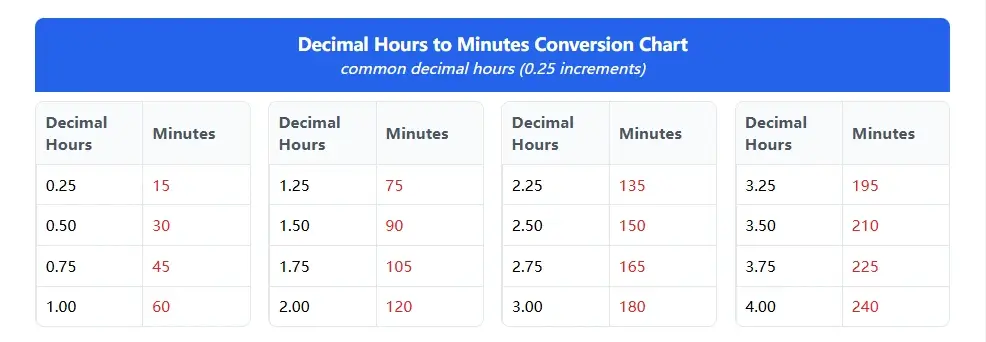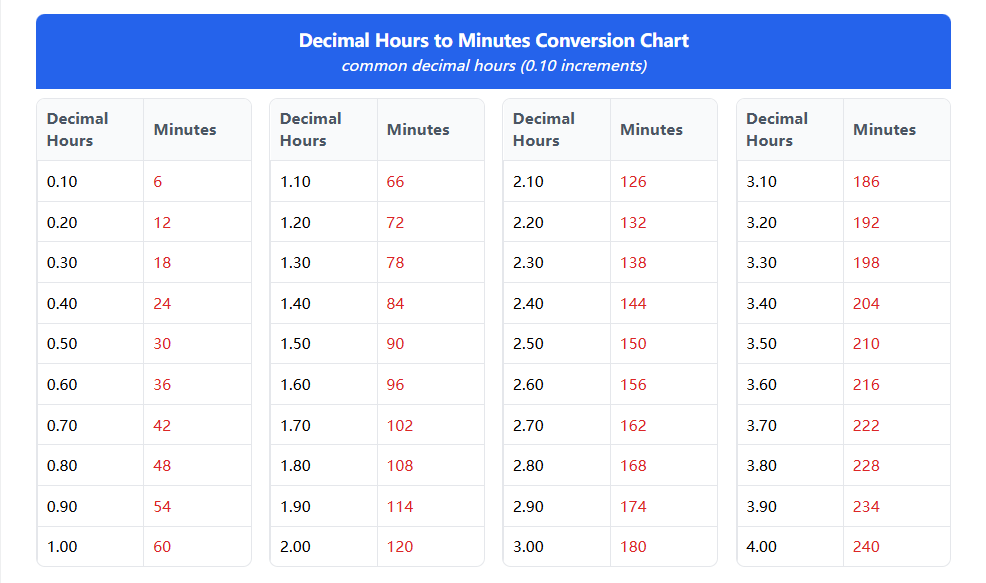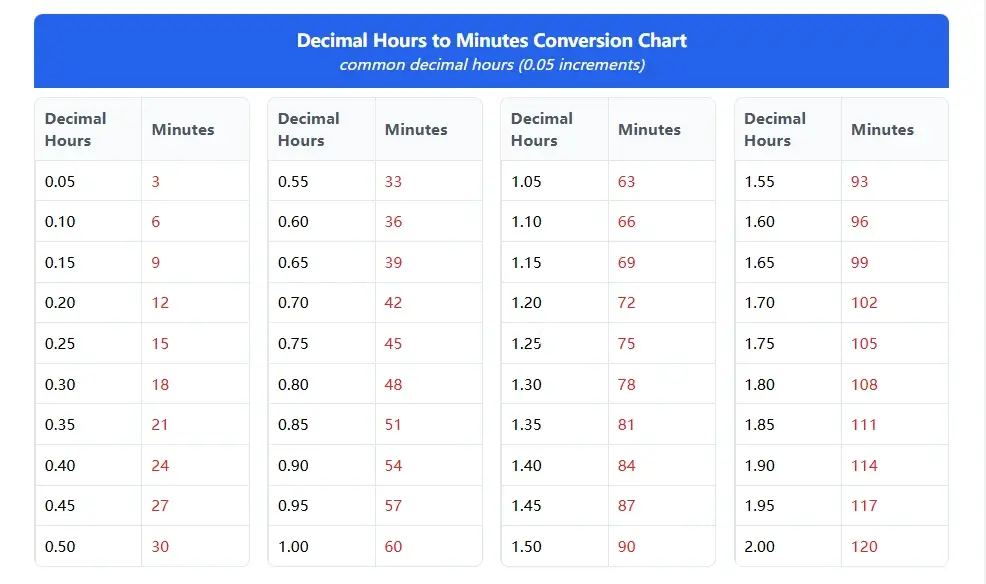Decimal Hours to Minutes Conversion Charts Guide
Decimal hours to minutes conversion charts represent the backbone of modern time management systems, enabling professionals to seamlessly translate decimal time formats into traditional minute measurements. These essential reference tools eliminate calculation errors while accelerating workflow efficiency across diverse business applications. For those who prefer a printable reference, a downloadable PDF version of the time conversion chart for hours to decimal minutes is available.
The Critical Role of Decimal Hours to Minutes Conversion
In today's data-driven business environment, decimal hours to minutes conversion serves as a fundamental bridge between automated time tracking systems and traditional reporting requirements. Organizations utilizing decimal time formats for payroll processing, project management, and client billing must frequently convert these values to minutes for compliance reporting, stakeholder communication, and operational analysis.
The conversion process follows a straightforward mathematical principle: multiplying decimal hours by 60 yields the equivalent minutes. However, the practical application of this conversion across hundreds or thousands of time entries demands reliable reference charts that ensure accuracy and consistency. A single conversion error in a high-stakes environment can cascade through billing systems, affecting revenue recognition and client relationships.
Understanding Decimal Hours to Minutes Conversion Precision
0.25 Precision: The Industry Standard
Quarter-hour increments (0.25) represent the most widely adopted precision level for decimal hours to minutes conversion in professional environments. This format aligns perfectly with traditional timekeeping practices while maintaining the computational advantages of decimal systems.
- Standard payroll processing and employee time tracking
- Client billing and professional services invoicing
- Project milestone tracking and resource allocation
- Compliance reporting for labor regulations
0.25 Decimal Increments Hours to Minutes Chart

This quarter-hour conversion chart covers the most common decimal hour values used in professional time tracking, from 0.25 hours (15 minutes) to 4.00 hours (240 minutes).
0.1 Precision: Enhanced Accuracy
Tenth-hour increments (0.1) provide enhanced precision for applications requiring more granular time measurement. This format proves particularly valuable in consulting environments, detailed project tracking, and specialized billing scenarios where precise time allocation drives revenue optimization.
0.1 Decimal Increments Hours to Minutes Chart

The tenth-hour chart provides precise conversions for decimal hours in 0.1 increments, essential for detailed project tracking and consulting work where accuracy matters.
0.05 Precision: Maximum Granularity
0.05 hour increments deliver maximum granularity for specialized applications requiring exceptional precision. This format supports advanced project management methodologies, research time tracking, and high-precision billing scenarios where minute-level accuracy determines operational success.
0.05 Decimal Increments Hours to Minutes Chart

This high-precision chart covers 0.05-hour increments, providing the granular detail needed for specialized applications requiring maximum accuracy in decimal hours to minutes conversion.
Strategic Applications of Decimal Hours to Minutes Conversion
Human Resources and Payroll Management
HR departments leverage decimal hours to minutes conversion charts to ensure accurate payroll processing and compliance with labor regulations. When automated time tracking systems capture employee hours in decimal format, these charts enable rapid conversion to traditional time formats required for government reporting and employee communication.
For instance, when an employee logs 7.75 decimal hours, HR professionals can instantly reference conversion charts to determine this equals 465 minutes or 7 hours and 45 minutes. This conversion accuracy prevents payroll discrepancies and ensures compliance with overtime calculations.
Project Management and Resource Allocation
Project managers utilize decimal hours to minutes conversion to align time tracking data with stakeholder reporting preferences. While project management software may store time in decimal format for computational efficiency, client presentations and team communications often require traditional time formats.
Converting decimal hours to minutes enables project managers to present time allocations in familiar formats, improving stakeholder comprehension and project transparency. This conversion capability proves essential when coordinating resources across teams using different time tracking methodologies.
Professional Services and Client Billing
Professional services firms depend on accurate decimal hours to minutes conversion for transparent client billing and invoice preparation. Legal firms, consulting agencies, and technical service providers must convert decimal time entries to minutes for client invoices that clearly communicate time investments.
When billing clients at hourly rates, converting 2.33 decimal hours to 140 minutes (2 hours and 20 minutes) provides clarity that builds client trust and facilitates payment processing. This conversion transparency reduces billing disputes and strengthens client relationships.
Implementation Best Practices for Conversion Charts
Organizational Standardization
Successful implementation of decimal hours to minutes conversion requires organizational standardization of precision levels and conversion methodologies. Teams should establish consistent rounding practices and document conversion procedures to ensure accuracy across all time-related calculations.
- Define standard precision levels for different application types
- Establish rounding protocols for fractional minute calculations
- Document conversion procedures for team reference
- Implement quality control measures for critical conversions
Technology Integration
Modern organizations integrate decimal hours to minutes conversion capabilities directly into their time tracking and project management systems. This integration eliminates manual conversion steps while maintaining the flexibility to present time data in multiple formats based on stakeholder requirements.
Automated conversion systems should include validation mechanisms to verify conversion accuracy and flag potential errors before they impact payroll processing or client billing. These systems enhance operational efficiency while maintaining the precision required for professional time management.
Advanced Conversion Scenarios and Solutions
Bulk Conversion Operations
Large-scale decimal hours to minutes conversion operations require systematic approaches that maintain accuracy while processing high volumes of time data. Organizations processing hundreds of time entries daily benefit from automated conversion tools that reference standardized conversion charts. For high-volume processing needs, our bulk decimal hours to minutes converter enables efficient batch processing with Excel export capabilities.
Bulk conversion scenarios commonly arise during payroll processing periods, project reporting cycles, and client billing preparation. When reverse conversion is needed, the decimal minutes to hours converter provides the complementary functionality for comprehensive time format management. Efficient conversion systems enable rapid processing of these high-volume operations while maintaining the accuracy standards required for financial and compliance reporting.
Cross-System Data Integration
Modern business environments often require decimal hours to minutes conversion when integrating data between systems with different time format requirements. ERP systems, payroll platforms, and project management tools may utilize varying time formats, necessitating accurate conversion capabilities.
Successful cross-system integration depends on reliable conversion protocols that maintain data integrity throughout the transfer process. These protocols ensure that time data remains accurate regardless of the format transformations required for system compatibility.
Quality Assurance and Validation Procedures
Conversion Accuracy Verification
Professional time management requires robust quality assurance procedures to verify decimal hours to minutes conversion accuracy. Organizations should implement systematic validation processes that identify and correct conversion errors before they impact critical business operations.
Validation procedures should include spot-checking conversion results against reference charts, implementing automated verification algorithms, and establishing approval workflows for high-value time entries. These measures ensure conversion accuracy while maintaining operational efficiency.
Error Prevention and Correction
Effective error prevention strategies focus on eliminating common conversion mistakes through standardized procedures and automated validation systems. Common errors include incorrect decimal placement, rounding inconsistencies, and format confusion between different precision levels.
When conversion errors occur, rapid correction procedures minimize their impact on business operations. Error correction protocols should include root cause analysis to prevent similar mistakes and continuous improvement measures to enhance conversion accuracy over time.
Future Trends in Time Conversion Technology
Artificial Intelligence Integration
Emerging artificial intelligence technologies promise to revolutionize decimal hours to minutes conversion through intelligent automation and predictive accuracy enhancement. AI-powered systems can learn from historical conversion patterns to optimize accuracy and identify potential errors before they occur.
Machine learning algorithms can analyze conversion data to identify trends, predict common conversion scenarios, and recommend optimization strategies for improved efficiency. These capabilities represent the next evolution in professional time management technology.
Real-Time Conversion Capabilities
Real-time conversion technologies enable instant decimal hours to minutes transformation as time data is captured, eliminating delays in reporting and analysis. These capabilities support dynamic project management and immediate billing accuracy verification.
Real-time conversion systems integrate seamlessly with mobile time tracking applications, enabling field workers and remote teams to access accurate conversion capabilities regardless of their location or device preferences.
Conclusion: Mastering Professional Time Conversion
Decimal hours to minutes conversion charts serve as indispensable tools for modern professional time management, enabling accurate, efficient transformation between time formats. Organizations that master these conversion capabilities gain competitive advantages through improved accuracy, enhanced efficiency, and superior stakeholder communication.
The strategic implementation of conversion charts, combined with appropriate technology integration and quality assurance procedures, creates robust time management systems that support organizational growth and operational excellence. As business environments continue evolving toward greater precision and efficiency, decimal hours to minutes conversion capabilities remain essential for professional success.